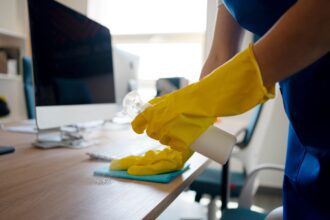In today’s fast-paced business environment, maintaining a clean and organized workspace is crucial for productivity and profitability. However, commercial cleaning can be a time-consuming task, taking away from core business activities. Fortunately, there are strategies to maximize efficiency with commercial cleaning, saving valuable time and resources.
Optimize Your Cleaning Schedule
Effective scheduling is key to maximizing efficiency in commercial cleaning. Identify peak usage areas and prioritize cleaning schedules accordingly. Allocate specific times for daily, weekly, and monthly tasks to maintain consistency.
Streamline Cleaning Processes
Analyze current cleaning processes and eliminate unnecessary steps. Simplify tasks by assigning specific responsibilities to team members, promoting accountability and reducing confusion.
Invest in Efficient Equipment
Upgrade to modern, high-performance cleaning equipment designed for speed and efficiency. Consider investing in automated cleaning tools, such as robotic vacuums or floor scrubbers, to reduce labor time.
Implement a Zone Cleaning System
Divide your facility into designated zones, assigning specific tasks and schedules to each area. This approach enables efficient allocation of resources and minimizes duplication of effort.
Leverage Technology for Enhanced Productivity
Utilize innovative cleaning management software to streamline operations, track progress, and identify areas for improvement. Implement mobile apps for real-time communication and task assignment.
Train and Develop Your Cleaning Team
Provide comprehensive training on efficient cleaning techniques, equipment operation, and safety protocols. Foster a culture of continuous improvement, encouraging team members to share suggestions and best practices.
Outsource Non-Core Functions
Consider outsourcing specialized cleaning services, such as window cleaning or carpet shampooing, to free up internal resources for core business activities.
Conduct Regular Audits and Assessments
Perform regular audits to identify areas for process improvement, ensuring that cleaning protocols are effective and efficient. Use data-driven insights to refine strategies and optimize resource allocation.
Implement Sustainable Cleaning Practices
Adopt eco-friendly cleaning products and practices, reducing waste and minimizing environmental impact. This approach not only supports sustainability but also enhances your organization’s reputation.
Enhance Customer Experience
Maintain a clean and welcoming environment, ensuring customer satisfaction and loyalty. Implement measures to minimize disruptions during cleaning operations, preserving a positive customer experience.
Foster Collaboration with Facility Management
Establish open communication channels with facility management teams, ensuring alignment on cleaning schedules, protocols, and priorities.
Prioritize High-Touch Areas
Focus on high-touch areas, such as door handles, light switches, and countertops, to prevent the spread of germs and illnesses. Implement enhanced cleaning protocols for these critical zones.
Implement a Preventative Maintenance Program
Regularly inspect and maintain equipment, reducing downtime and extending its lifespan. Schedule preventative maintenance during off-peak hours to minimize disruptions.
Leverage Daylight Cleaning
Take advantage of natural daylight by scheduling cleaning operations during the day, reducing energy consumption and enhancing visibility for more effective cleaning.
Streamline Supply Chain Management
Optimize inventory management, ensuring that necessary cleaning supplies are always on hand. Implement a just-in-time ordering system to minimize stockpiling and reduce waste.
Enhance Team Productivity with Ergonomic Tools
Provide ergonomic cleaning tools and equipment, reducing fatigue and discomfort for your team members. This approach boosts productivity, morale, and overall job satisfaction.
Implement a Recognition and Reward System
Establish a recognition and reward system, incentivizing team members to strive for excellence in efficiency and productivity. Foster a positive work environment, encouraging collaboration and teamwork.
Monitor Progress and Adjust Strategies
Regularly track key performance indicators (KPIs), monitoring progress toward efficiency goals. Analyze data to identify areas for improvement, refining strategies as needed.
By implementing these time-saving strategies, commercial cleaning operations can maximize efficiency, reducing labor costs, enhancing productivity, and promoting a positive work environment. Remember to continuously monitor progress, refine approaches as needed, and prioritize customer satisfaction and sustainability.
